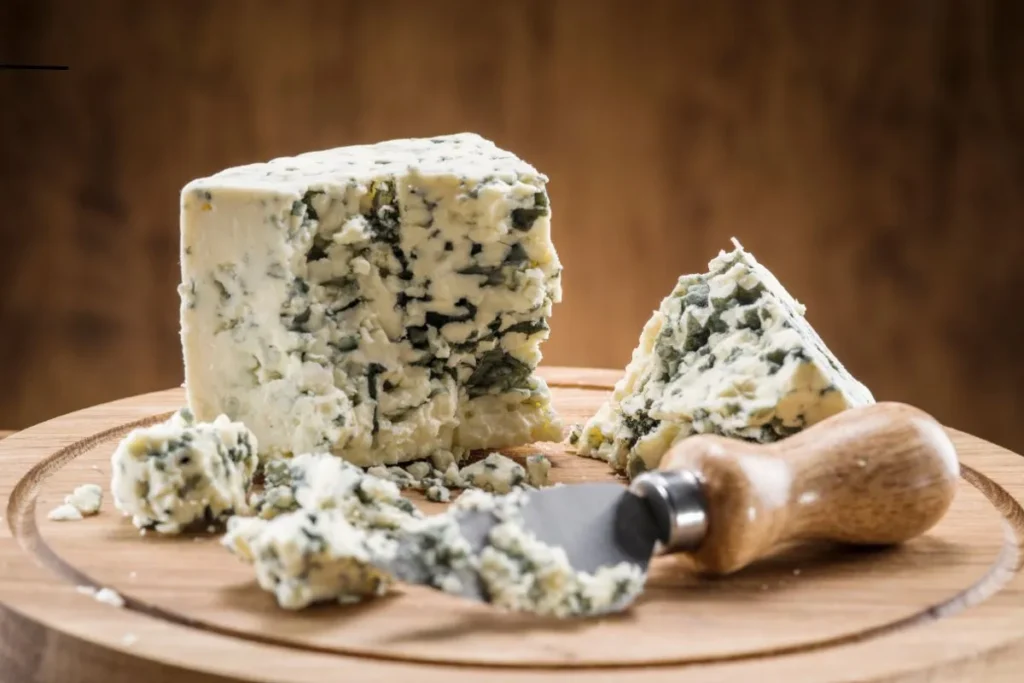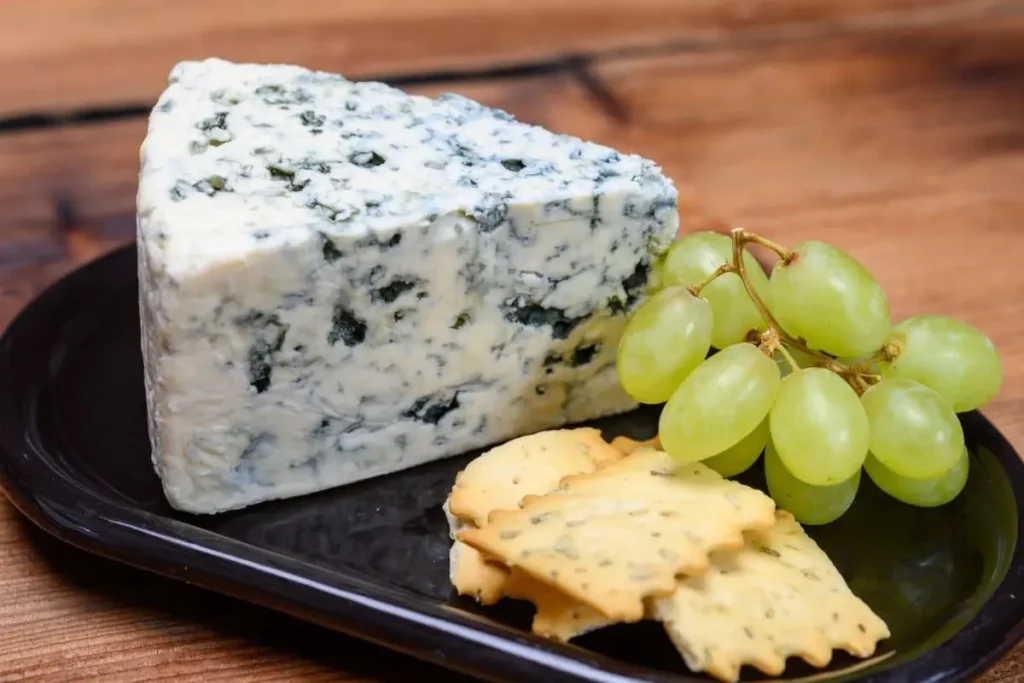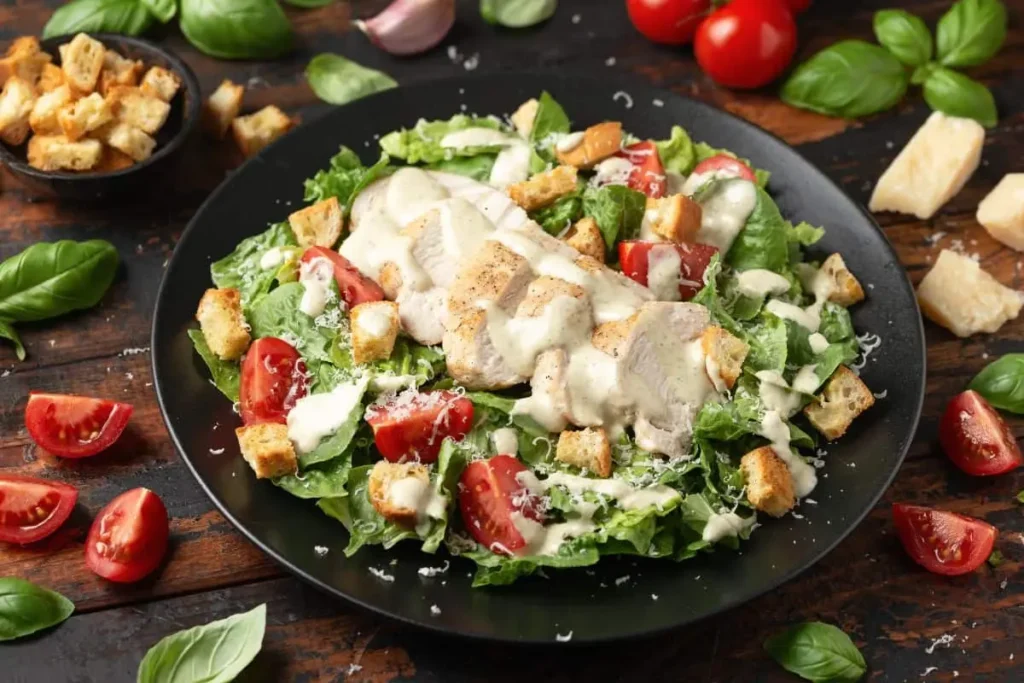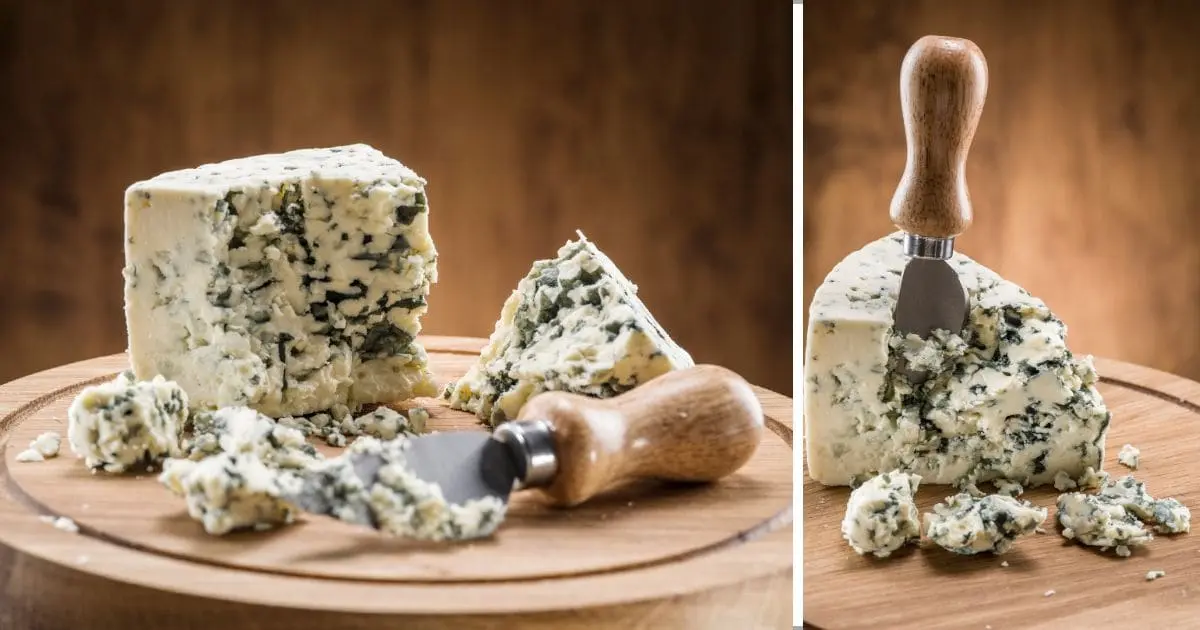Danish blue cheese, also known as Danablu, is a semi-soft blue cheese made from cow’s milk. It has a creamy and crumbly texture with a distinct blue veining throughout. The flavour is tangy and sharp, with a pleasant saltiness that balances its creamy richness.
Among the various types of cheese available, Danish Blue stands out for its unique qualities. Whether enjoyed on its own, incorporated into recipes, or paired with fine wines
Danish blue cheese is often enjoyed alone, in salads, or paired with fruits and nuts. It is also a popular choice for melting over steaks and burgers due to its robust flavour.

Top 12 Facts About Danish Blue Cheese:
- Source of Milk: Made from cow milk.
- Texture: Creamy and crumbly with blue mould veins.
- Colour: White with blue and greenish-blue veining.
- Flavour: Bold, tangy, and slightly salty.
- Fat Content: 30-35% fat.
- Aging Time: Aged for 2-3 months.
- Pasteurized: Usually pasteurized.
- Country of Origin: Denmark.
- Town: Produced in various Danish regions.
- Named After: Named for its Danish origin and blue mould.
- Certification: No specific certification.
- Uses: Great for salads, sauces, and as a standalone cheese.
ALSO READ: Complete guide to Feta cheese
This blog post will explore the unique characteristics, history, production process, culinary uses, and health benefits of Danish Blue Cheese:
History of Danish Blue Cheese
The history of Danish Blue Cheese dates back to the early 20th century. It was developed by Marius Boel, a Danish cheesemaker, in the 1920s. Boel’s aim was to create a blue cheese that could rival the famous Roquefort cheese from France.
Using cow’s milk instead of traditional sheep’s milk, Boel succeeded in crafting a cheese with a creamy texture and robust flavour, which quickly gained popularity.
In 1952, Danish Blue Cheese received protected geographical indication (PGI) status, ensuring that only cheese produced in Denmark following specific guidelines could be labelled as Danablu.
This status not only helped to maintain the quality and authenticity of Danish Blue Cheese but also solidified its place in the world of fine cheeses.
Characteristics of Danish Blue Cheese
Danish Blue Cheese is known for its distinctive blue veins, which are created by the introduction of Penicillium roqueforti mold during the cheese-making process.
These veins give the cheese its characteristic appearance and contribute to its strong, tangy flavor. The cheese has a semi-soft texture, making it easy to spread or crumble.
One of the key features of Danish Blue Cheese is its creamy consistency. Unlike some other blue cheeses, which can be crumbly and dry.
Danish Blue Cheese maintains a smooth and luscious texture. This makes it an excellent choice for various culinary applications, from spreading on crackers to incorporating it into sauces and dressings.
ALSO READ: Discovering The Cottage Cheese
Danish Blue cheese, developed by Marius Boel, was created to rival Roquefort. Learn more about Danish cheeses on Wikipedia and blue cheese varieties on Wikipedia.
The Production Process
The production of Danish Blue Cheese involves several meticulous steps to achieve its signature taste and texture. Here is an overview of the process:
Milk Selection and Pasteurization: High-quality cow’s milk is used as the base for Danish Blue Cheese. The milk is pasteurized to eliminate any harmful bacteria.
Culturing and Coagulation: Starter cultures and rennet are added to the milk to initiate the coagulation process. This helps to form curds, which are then cut into small pieces to release whey.
Moulding and Salting: The curds are placed into molds, where they begin to take shape. The cheese is then salted, either by rubbing the surface with salt or immersing it in a brine solution. This step enhances the flavour and helps to preserve the cheese.
Piercing and Aging: The cheese is pierced with stainless steel needles to create air channels, which allow the Penicillium roqueforti mold to develop. The cheese is then aged for several weeks to months, during which time the mold grows and creates the characteristic blue veins.
Packaging and Distribution: Once the cheese has reached the desired level of maturity, it is packaged and distributed to markets around the world.
Culinary Uses of Danish Blue Cheese
Danish Blue Cheese is incredibly versatile and can be used in a variety of culinary applications. Here are some popular ways to enjoy this delightful cheese:

Cheese Platters: Danish Blue Cheese is a fantastic addition to any cheese platter. Its bold flavor pairs well with fruits, nuts, and crackers, providing a delightful contrast to milder cheeses like cottage cheese and parmesan cheese.
Salads: Crumble Danish Blue Cheese over salads to add a tangy and creamy element. It pairs particularly well with mixed greens, walnuts, and dried cranberries.
Dressings and Dips: Incorporate Danish Blue Cheese into dressings and dips for a rich and flavorful addition. It can be blended with sour cream, mayonnaise, and herbs to create a delectable blue cheese dressing.
Burgers and Sandwiches: Danish Blue Cheese can elevate burgers and sandwiches to a whole new level. Its creamy texture and robust flavor make it an excellent topping for beef, chicken, or vegetarian patties.
Sauces: Melt Danish Blue Cheese into sauces for pasta, steak, or vegetables. Its strong flavour adds depth and richness to various dishes.
ALSO READ: The Ultimate Guide to Cheddar Cheese
Health Benefits of Danish Blue Cheese
While Danish Blue Cheese is undoubtedly delicious, it also offers several health benefits when consumed in moderation. Here are some of the nutritional advantages of this cheese:
Rich in Calcium: Danish Blue Cheese is an excellent source of calcium, which is essential for maintaining strong bones and teeth. A single serving of this cheese can provide a significant portion of the recommended daily intake of calcium.
High in Protein: Cheese is a good source of protein, and Danish Blue Cheese is no exception. Protein is vital for muscle repair and growth, making it an important component of a balanced diet.
Contains Probiotics: The Penicillium roqueforti mold used in Danish Blue Cheese is a source of beneficial probiotics. These probiotics can support gut health and improve digestion.
Vitamin Content: Danish Blue Cheese contains various vitamins, including vitamin A, which is important for vision and immune function, and vitamin B12, which supports nerve health and the production of red blood cells.
Danish Blue Cheese and Wine Pairings
Pairing Danish Blue Cheese with the right wine can enhance its flavor and create a delightful tasting experience.

Here are some wine pairing suggestions for Danish Blue Cheese:
Port: The sweetness of port wine complements the tangy and salty flavour of Danish Blue Cheese. The rich, fruity notes of the port create a harmonious balance.
Sauternes: This French dessert wine, known for its sweetness and acidity, pairs wonderfully with the bold taste of Danish Blue Cheese. The contrast between the sweet wine and the tangy cheese is truly delightful.
Riesling: A slightly sweet Riesling can balance the strong flavor of Danish Blue Cheese. The wine’s acidity and fruity notes complement the cheese’s creaminess.
Chardonnay: A full-bodied Chardonnay with oak ageing can match the richness of Danish Blue Cheese. The wine’s buttery and vanilla notes enhance the cheese’s flavour.
Syrah/Shiraz: A robust Syrah or Shiraz with dark fruit flavours and peppery undertones can stand up to the intensity of Danish Blue Cheese. The wine’s bold character pairs well with the cheese’s strong taste.
ALSO READ: Mozzarella cheese
How to Store Danish Blue Cheese
Proper storage is essential to maintain the quality and flavour of Danish Blue Cheese. Here are some tips for storing this cheese:
Refrigeration: Danish Blue Cheese should be stored in the refrigerator at a temperature between 35°F and 45°F (1.6°C and 7.2°C). It’s best to keep it in the original packaging or wrap it in wax paper and place it in an airtight container.
Avoid Freezing: Freezing Danish Blue Cheese is not recommended, as it can affect the texture and flavor. The cheese may become crumbly and lose its creamy consistency.
Use Within a Few Weeks: Danish Blue Cheese is best enjoyed within a few weeks of purchase. Over time, the flavor may become stronger and more pungent.
Check for Mold: While Danish Blue Cheese naturally contains blue mold, any additional mold growth on the surface should be removed. If the cheese develops an off smell or unusual texture, it’s best to discard it.
Cooking with Danish Blue Cheese
Danish Blue Cheese can be a versatile ingredient in the kitchen. Here are some recipe ideas to inspire your culinary creativity:

Blue Cheese Stuffed Mushrooms: Fill large mushroom caps with a mixture of Danish Blue Cheese, breadcrumbs, garlic, and herbs. Bake until the mushrooms are tender and the filling is golden brown.
Blue Cheese and Pear Salad: Toss mixed greens with sliced pears, candied walnuts, and crumbled Danish Blue Cheese. Drizzle with a balsamic vinaigrette for a refreshing and flavorful salad.
Blue Cheese Pasta: Cook your favourite pasta and toss it with a creamy sauce made from Danish Blue Cheese, heavy cream, and a touch of garlic. Top with freshly ground black pepper and chopped parsley.
Blue Cheese Burger: Grill or pan-fry a burger patty and top it with a generous slice of Danish Blue Cheese. Serve on a toasted bun with lettuce, tomato, and caramelized onions.
Blue Cheese Dip: Blend Danish Blue Cheese with sour cream, mayonnaise, and a squeeze of lemon juice. Serve with fresh vegetables, chips, or bread for a delightful appetizer.
ALSO READ: Exploring Parmesan or Parmigiano-Reggiano cheese
Danish Blue Cheese in Popular Culture
Danish Blue Cheese has made its mark not only in the culinary world but also in popular culture. It has been featured in various television shows, movies, and literature, often symbolizing sophistication and gourmet indulgence. The cheese’s unique flavour and distinctive appearance make it a favourite among chefs and food enthusiasts.
In recent years, Danish Blue Cheese has also gained attention in the world of artisanal and gourmet foods. Its rich history and traditional production methods have been celebrated in culinary festivals and cheese competitions, further cementing its status as a beloved cheese variety.
Comparing Danish Blue Cheese with Other Blue Cheese
While Danish Blue Cheese is a standout in its own right, it’s interesting to compare it with other well-known blue cheeses. Here are some comparisons with popular blue cheeses:
Roquefort: Originating from France, Roquefort is made from sheep’s milk and has a crumbly texture with a sharp, tangy flavour. Danish Blue Cheese, made from cow’s milk, is creamier and milder in taste.
Gorgonzola: This Italian blue cheese can be either creamy (Gorgonzola Dolce) or crumbly and strong (Gorgonzola Piccante). Danish Blue Cheese falls somewhere in between, with a semi-soft texture and a bold yet balanced flavour.
Stilton: Known as the “King of Cheeses” in England, Stilton has a rich and robust flavour with a crumbly texture. Danish Blue Cheese is softer and creamier, making it more versatile in culinary applications.
Cabrales: This Spanish blue cheese is made from a blend of cow, sheep, and goat milk, resulting in a very strong and pungent flavor. Danish Blue Cheese, with its milder taste, is more approachable for those new to blue cheeses.
Conclusion
Danish Blue Cheese is a true gem in the world of cheeses, offering a distinctive flavor and creamy texture that sets it apart from other varieties. From its humble beginnings in Denmark to its place on gourmet cheese platters around the world.
Danish Blue Cheese has earned its reputation as a beloved and versatile cheese. Whether enjoyed on its own, incorporated into recipes, or paired with fine wines, Danish Blue Cheese continues to captivate the palates of cheese lovers everywhere.
ALSO READ: The Ultimate Guide to Ricotta Cheese
For a deeper dive into the history and creation of Danish Blue Cheese, or Danablu, which was first developed by Marius Boel in 1927, visit Skjalden’s guide and explore more details on Wikipedia.
FAQ
What is Danish blue cheese?
Danish blue cheese, also known as Danablu, is a semi-soft, blue-veined cheese produced in Denmark. It has a rich, creamy texture and a tangy flavor, making it a popular choice for cheese platters and culinary dishes.
How does Danish blue cheese taste?
Danish blue cheese has a bold, tangy flavor with a buttery richness. The blue veins contribute a sharp, savory taste, making it distinct from other blue cheeses.
What are some common uses for Danish blue cheese?
Danish blue cheese can be enjoyed on cheese boards, crumbled over salads, melted into sauces, or used in recipes for dips and dressings. Its robust flavor pairs well with fruits, nuts, and various meats.
Is Danish blue cheese suitable for cooking?
Yes, Danish blue cheese is excellent for cooking! It melts well and can enhance the flavor of soups, sauces, and casseroles. It’s particularly delicious in creamy pasta dishes or on pizza.
More on Cheese
- Exploring Parmesan or Parmigiano-Reggiano cheese
- Mozzarella cheese | Origins, Production, uses
- The Ultimate Guide to Ricotta Cheese
- Homemade Ricotta Cheese Recipe
- Complete guide to Feta cheese
- Discovering The Cottage Cheese
- The Ultimate Guide to Bel Paese Cheese
- Cream Cheese Essentials: Everything You Need to Know
- Camembert Cheese: A Comprehensive Guide
- 27 different types of cheese: their origin and uses
- Service of cheese in restaurants
Subscribe and join our community of hospitality professionals & students — get insights, tips, and the latest updates delivered straight to your inbox!







